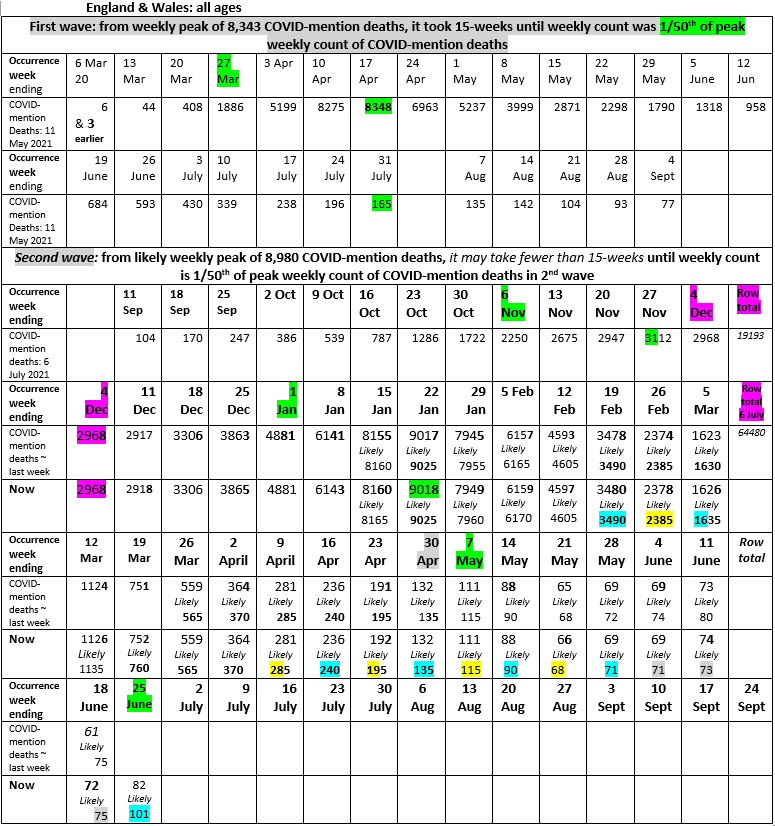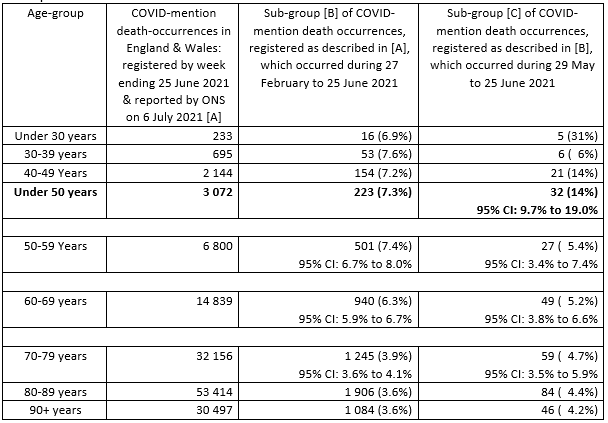The Office for National Statistics (ONS) have released provisional counts of the number of deaths registered in England and Wales in the week ending 25 June 2021.
Prof Sheila Bird, Formerly Programme Leader, MRC Biostatistics Unit, University of Cambridge, said:
“Provisional counts for COVID-mention deaths by date of occurrence are key data. England & Wales experienced over 87,000 (nearest 1000) COVID-mention deaths by the time that the weekly count of COVID-mention deaths is fewer than 1/50th of the peak count in Wave 2 of over 9,000 COVID-mention deaths. If so, then very sadly Wave 2 will have claimed 67% more lives than Wave 1.
“Wave 1 peak count was 8,348 COVID-mention deaths and it took 15 weeks until the Wave 1 weekly count dropped below 1/50th of Wave 1’s peak-count (ie below 167). Wave 2 achieved the corresponding goal in fewer than 15 weeks, but by one week only (ie in week ended 30 April 2021).
“My table shows COVID-mention deaths in England & Wales (by week of occurrence) in Wave 2 from early September 2020 to late June 2021. Both a) the pattern of registration-delays and b) fortnightly rates of change in the occurrence of COVID-mention deaths are used to estimate likely totals for COVID-mention deaths in the most recent weeks of occurrence.
“In England and Wales, not all deaths which occurred in the week ending 25 June 2021 have yet been registered. Taking registration delay into account, we can expect around 100 COVID-mention deaths may have occurred in England & Wales in the week ended 25 June 2021, see Table, which is a significant increase on the previous week.
“Fortnightly rates had been decreasing (compare yellow to yellow; turquoise to turquoise), then stabilized (grey), and are now signalling upturn.

Wave 1 to 31 July 2020 = 52,248 or 52,250 (nearest 50); there follows 5-week inter-regnum = 551
Wave 2: 5 Sept to 30 April 2021 = 87,315 (@ 9 July).
Wave 2 expectation is 87,000 (nearest 1000) COVID-mention deaths until weekly count is below 1/50th peak count of COVID-mention deaths (180).
Hence, Wave 2 expectation is at least 67% higher death toll in England & Wales than in Wave 1.
NB: Vaccine effectiveness in older age-groups may account, in part or whole, for the much lower percentage that recent COVID-mention deaths [B] represent of all COVID-mention deaths by age-group.
Compared to citizens aged 50+ years, the percentage of column [B] COVID-mention deaths that occurred since 28th May 2021 [C} is higher for those aged under 50 years (14%), for whom vaccine roll-out is still incomplete.

Prof Kevin McConway, Emeritus Professor of Applied Statistics, The Open University, said:
“The picture from the latest week’s provisional ONS data on death registrations in England and Wales is reasonably encouraging, though there are some reminders that we still need to be cautious on Covid-19. The latest data go up to the week 19-25 June. On deaths from all causes, the position does generally look good. The number of deaths registered in England and Wales in the latest week is lower than the previous week by about 8%. This isn’t a time of year when numbers of registered deaths usually change much, so the fall this year does mean that once again the number of deaths is below the average of the five years 2015-19 – about 8% lower. So again there are no overall excess deaths – indeed there’s a deficit of deaths compared to the five-year average. That’s been the case every week since early March, apart from the two weeks before the latest one, when there were fairly small numbers of weekly excess deaths on this measure. However, to some extent at least, that might have been an anomaly caused by late registrations after the Spring bank holiday. It doesn’t show up in the numbers classified by the dates when the deaths actually occurred rather than when they are registered. Registered deaths from all causes are below the five-year average in England and in Wales taken separately, and in all the English regions. Also they were lower in the latest week than the week before in England and in Wales taken separately and in all the English regions. That’s all good news.
“The latest figures on deaths related to Covid-19 are encouraging on the face of it, but there are some less positive features in the details. The good news is that slightly fewer deaths were registered in England and Wales, that mentioned Covid-19 on the death certificate, in the latest week than in the week before. The number went down from 102 in the week ending 18 June to 99 in the week ending 25 June. That comes after a rise in the week ending 18 June compared to the week before that. But none of these changes are very large in either direction. But you might wonder how deaths mentioning Covid-19 are falling in this bulletin, when the numbers of deaths on the dashboard at coronavirus.data.gov.uk have been slowly rising in England and Wales (taken together) since early June. One relevant point is that it is the UK-wide figures for Covid deaths that are usually reported daily, and the rise in deaths in Scotland started rather earlier and has been clearer than in England and Wales. Most of the figures in this ONS bulletin are just for England and Wales. But Covid-19 deaths on the dashboard have been rising in England and Wales (taken together). Actually there are some fairly clear signs that they are in fact rising, though slowly, and that this simply isn’t clear on the data by date of registration.
“The clearest sign that deaths involving Covid-19 are rising comes from data classified by the date of occurrence of death rather than by the date of registration. Usually this is difficult to interpret for the most recent weeks, because it does take some time for a death to be registered, so that the counts by date of occurrence are incomplete for recent weeks, and particularly so for the latest week. (They are revised upwards in future weekly bulletins – that’s one reason why these numbers are labelled ‘provisional’.) However, the numbers of deaths involving Covid-19 in England and Wales, by date of occurrence, have been rising pretty steadily, though slowly, for several weeks. In the week ending 21 May, there were 66 deaths involving Covid-19. In the week ending 25 June, there were 82, and that latest number is bound to be revised upwards significantly in future bulletins as late registrations come in. This isn’t a huge increase, and the numbers are very low compared even to the position in late March and early April (559 deaths in the week ending 26 March, 364 in the week ending 2 April). The numbers of deaths, by date of occurrence, were above the latest week’s 82 throughout last summer, apart from one single week (week ending 4 September).
“Another less clear sign that Covid-19 deaths are probably increasing is that, in the latest week, the percentage of all registered deaths that involved Covid-19 is slightly higher than the previous week, and the previous week was in turn higher than the week before (though the percentage is still very low, at 1.1%). Finally, an indirect sign that the numbers are rising may be that, for the latest week, of the 99 registered deaths with Covid-19 on the death certificate, 84 of them (85%) have Covid-19 classified as the underlying cause of death. That percentage hasn’t been that high since the end of February – it tends to be higher when deaths are increasing or high, and lower when they are decreasing or low. At the start of June, under 60% of deaths involving Covid-19 actually had Covid-19 classified as their underlying cause.
“The fact that deaths from Covid-19 remain low, even though they seem to be increasing, while the number of cases continues to climb, must be a consequence of widespread vaccination, together with major improvements in treatment for people who become severely ill. One aspect of today’s data that also shows the role of vaccination is that, for registrations in the latest week, 44% of those who sadly died were aged under 70. Today ONS also published± a lot of detailed data on death registrations involving Covid-19 during 2020. Of all registered Covid-19 related deaths in England and Wales that year, only 16% were of people aged under 70, a much smaller proportion.”
±https://www.ons.gov.uk/peoplepopulationandcommunity/birthsdeathsandmarriages/deaths/articles/deathsregisteredduetocovid19/2020
All our previous output on this subject can be seen at this weblink:
www.sciencemediacentre.org/tag/covid-19
Declared interests
Prof Kevin McConway: “I am a Trustee of the SMC and a member of its Advisory Committee. I am also a member of the Public Data Advisory Group, which provides expert advice to the Cabinet Office on aspects of public understanding of data during the pandemic. My quote above is in my capacity as an independent professional statistician.”